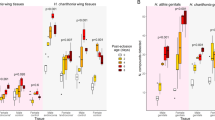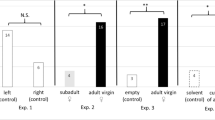Abstract
In burying beetles, Nicrophorus spp. (Coleoptera: Silphidae: Nicrophorinae) mate finding is mediated by male produced volatile compounds. To date, pheromone components of only two species have been identified. In an attempt to better understand the evolution of male pheromone signaling in burying beetles, we investigated the male released volatiles of ten Nicrophorus species and one closely related nicrophorine species, Ptomascopus mori. Volatiles emitted by calling males were collected in the laboratory by means of solid phase micro extraction and analyzed using gas chromatography coupled with mass spectrometry. Identified volatiles included short chain esters of 4-methylcarboxylic acids, terpenoids, and some other aliphatic compounds. The long-range volatile signals of the burying beetle species included in this study are blends of two to seven components. We found that methyl or ethyl esters of 4-methylheptanoic acid and 4-methyloctanoic acid are produced by eight of the ten investigated Nicrophorus species. These esters may play a key role in chemical communication. Their widespread occurrence suggests that these compounds did not evolve recently, but appeared relatively early in the phylogeny of the genus. Although Ptomascopus is considered the sister genus of Nicrophorus, P. morio males do not produce any of the Nicrophorus compounds, but release 3-methylalkan-2-ones, which are absent in Nicrophorus. A better understanding of the evolution of burying beetle pheromones, however, will only be possible once more species have been studied.

Similar content being viewed by others
Change history
25 November 2017
The original version of this article unfortunately contained a mistake. The name of the main component released by Nicrophorus defodiens in Fig. 1a should read “Fuscumyl acetate”, not “Fuscumol”.
References
Adams RP (2007) Identification of essential oil components by gas chromatography/mass spectrometry. Allured Publishing Corporation, Carol Stream
Adhikary P, Mukherjee A, Barik A (2015) Attraction of Callosobruchus maculatus (F.) (Coleoptera: Bruchidae) to four varieties of Lathyrus sativus L. seed volatiles. Bull Entomol Res 105:187–201
Babushok VI, Linstrom PJ, Zenkevich IG (2011) Retention indices for frequently reported compounds of plant essential oils. J Phys Chem Ref Data 40:43101-1–43101-47. https://doi.org/10.1063/1.3653552
Bartlett J (1987) Evidence for a sex attractant in burying beetles. Ecol Entomol 12:471–472
Beeler AE, Rauter CM, Moore AJ (1999) Pheromonally mediated mate attraction by males of the burying beetle Nicrophorus orbicollis: alternative calling tactics conditional on both intrinsic and extrinsic factors. Behav Ecol 10:578–584
Beeler AE, Rauter CM, Moore AJ (2002) Mate discrimination by females in the burying beetle Nicrophorus orbicollis: the influence of male size on attractiveness to females. Ecol Entomol 27:1–6
Břízová R, Vaníčková L, Faťarová M, Ekesi S, Hoskovec M, Kalinová B (2015) Analyses of volatiles produced by the African fruit fly species complex (Diptera, Tephritidae). ZooKeys 540:385–404
Burger BV, Le Roux M, Spies HSC, Truter V, Bigalke RC (1981) Mammalian pheromone studies. IV. Terpenoid compounds and hydroxy esters from the dorsal gland of the springbok, Antidorcas marsupialis. Z Naturforsch C 36:340–343
Chemnitz J, Jentschke PC, Ayasse M, Steiger S (2015) Beyond species recognition: somatic state affects long-distance sex pheromone communication. Proc Roy Soc B Biol Sci 282:20150832. https://doi.org/10.1098/rspb.2015.0832
Choi H-S (2003) Character impact odorants of Citrus Hallabong [(C. unshiu Marcov×C. sinensis Osbeck)xC. reticulata Blanco] cold-pressed peel oil. J Agric Food Chem 51:2687–2692. https://doi.org/10.1021/jf021069o
Corey EJ, Suggs JW (1975) Pyridinium chlorochromate, an efficient reagent for oxidation of primary and secondary alcohols to carbonyl compounds. Tetrahedron Lett 31:2647–2650
Dharmawan J, Kasapis S, Sriramula P et al (2009) Evaluation of aroma-active compounds in Pontianak orange peel oil (Citrus nobilis Lour. var. microcarpa Hassk.) by gas chromatography-olfactometry, aroma reconstitution, and omission test. J Agric Food Chem 57:239–244. https://doi.org/10.1021/jf801070r
Eggert A-K (1992) Alternative male mate-finding tactics in burying beetles. Behav Ecol 3:243–254
Eggert A-K, Müller JK (1989) Mating success of pheromone-emitting Necrophorus males: do attracted females discriminate against resource owners? Behaviour 110:248–257
Ferezou JP, Berreur-Bonnenfant J, Meusy JJ, Barbier M, Suchý M, Wipf HK (1977) 6,10,14-Trimethylpentadecan-2-one and 6,10,14-trimethyl-5-trans,9-trans-13-pentadecatrien-2-one from the androgenic glands of the male crab Carcinus maenas. Experientia 33:290
Fonseca MG, Vidal DM, Zarbin PHG (2010) Male-produced sex pheromone of the cerambycid beetle Hedypathes betulinus: chemical identification and biological activity. J Chem Ecol 36:1132–1139
Francke W, Schulz S (1999) Pheromones. Mori K (ed) Comprehensive Natural Products Chemistry 8:197–261. https://doi.org/10.1016/B978-0-08-091283-7.00052-7
Gries G, Gries R, Perez AL et al (1994) Aggregation pheromone of the African rhinoceros beetle, Oryctes monoceros (Olivier) (Coleoptera: Scarabaeidae). Z Naturforsch C. Biosci 49:363–366. https://doi.org/10.1515/znc-1994-5-614
Haberer W, Schmitt T, Peschke K et al (2008) Ethyl 4-methyl heptanoate: a male-produced pheromone of Nicrophorus vespilloides. J Chem Ecol 34:94–98. https://doi.org/10.1007/s10886-007-9406-y
Haberer W, Schmitt T, Schreier P, Müller JK (2011) Intended and unintended receivers of the male pheromones of the burying beetles Nicrophorus humator and Nicrophorus vespilloides. Entomol Exp Appl 140:122–126. https://doi.org/10.1111/j.1570-7458.2011.01143.x
Haberer W, Steiger S, Müller JK (2014) Dynamic changes in volatile emissions of breeding burying beetles. Physiol Entomol 39:153–164. https://doi.org/10.1111/phen.12059
Hallett RH, Perez AL, Gries G et al (1995) Aggregation pheromone of coconut rhinoceros beetle, Oryctes rhinoceros (L) (Coleoptera, Scarabaeidae). J Chem Ecol 21:1549–1570. https://doi.org/10.1007/BF02035152
Ho H-Y, Millar JG (2001a) Identification and synthesis of a male-produced sex pheromone from the stink bug Chlorochroa sayi. J Chem Ecol 27:1177–1201
Ho H-Y, Millar JG (2001b) Identification and synthesis of male-produced sex pheromone components of the stink bugs Chlorochroa ligata and Chlorochroa uhleri. J Chem Ecol 27:2067–2095
Islam N, Bacala R, Moore A, Vanderwel D (1999) Biosynthesis of 4-methyl-1-nonanol: female- produced sexpheromone of the yellow mealworm beetle, Tenebrio molitor (Coleoptera: Tenebrionidae). Insect Biochem Mol Biol 29:201–208
Joung MJ, Ahn JH, Lee DW, Yoon NM (1998) Coupling reaction of alkenes with alpha-bromo carboxylic acid derivatives using nickel boride and borohydride exchange. J Org Chem 63:2755–2757
Kalinová B, Podskalská H, Růzicka J, Hoskovec M (2009) Irresistible bouquet of death--how are burying beetles (Coleoptera: Silphidae: Nicrophorus) attracted by carcasses. Naturwissenschaften 96:889–899. https://doi.org/10.1007/s00114-009-0545-6
Lazari DM, Skaltsa HD, Constantinidis T (2000) Volatile constituents of Centaurea pelia DC ., C . thessala Hausskn. subsp. drakiensis (Freyn & Sint.) Georg. and C. zuccariniana from Greece. Flavour Fragr J 15:7–11
Li Y, Lu B, Li C, Li Y (2003) First total synthesis of (±)hedaol B. Synth Commun 33:1417–1423. https://doi.org/10.1081/SCC-120018704
Midgley G, Thomas CB (1987) Selectivity of radical formation in the reaction of carbonyl compounds with manganese(III) acetate. J Chem Soc Perkin Trans II:1003–1108
Müller JK, Eggert A-K (1987) Effects of carrion-independent pheromone emission by burying beetles (Silphidae: Necrophorus). Ethology 76:297–304
Müller JK, Braunisch V, Hwang W, Eggert A-K (2007) Alternative tactics and individual reproductive success in natural associations of the burying beetle, Nicrophorus vespilloides. Behav Ecol 18:196–203. https://doi.org/10.1093/beheco/arl073
Mulrey TEP, Eggert A-K, Sakaluk S (2015) Switching tactics: phenotypic plasticity in the alternative mate-finding tactics of burying beetles. Anim Behav 108:175–182. https://doi.org/10.1016/j.anbehav.2015.07.025
Nagano M, Suzuki S (2008) Number and size of clutch in Ptomascopus morio (Coleoptera: Silphidae: Nicrophorinae), with comparisons to Nicrophorus. Entomol Sci 11:153–157. https://doi.org/10.1111/j.1479-8298.2008.00267.x
Peck B (1982) The life history of the Japanese carrion beetle Ptomascopus morio and the origins of parental care in Nicrophorus (Coleoptera, Silphidae, Nicrophorini). Psyche 89:107–112
Pukowski E (1933) Ökologische Untersuchungen an Necrophorus F. Z Morphol Ökol Tiere 27:595–618
Rochat D, Mohammadpoor K, Malosse C et al (2004) Male aggregation pheromone of the date palm fruit stalk borer Oryctes elegans. J Chem Ecol 30:387–407
Saïd I, Hasni N, Abdallah Z et al (2015) Identification of the aggregation pheromone of the date palm root borer Oryctes agamemnon. J Chem Ecol 41:446–457
Schulz S, Boppré M, Vane-Wright RI (1993) Specific mixtures of secretions from male scent organs of African milkweed butterflies (Danainae). Phil Trans Royal Soc London B 342:161–181
Sikes DS, Venables C (2013) Molecular phylogeny of the burying beetles (Coleoptera: Silphidae: Nicrophorinae). Mol Phylogenet Evol 69:552–565. https://doi.org/10.1016/j.ympev.2013.07.022
Silk PJ, Sweeny JD, Wu J, Price J, Gutowski JM, Kettela EG (2007) Evidence for a male-produced pheromone in Tetropium fuscum (F.) and Tetropium cinnamopterum (Kirby) (Coleoptera: Cerambycidae). Naturwissenschaften 94:697–701
Suzuki S, Nagano M (2005) Host defense in Nicrophorus quadripunctatus against brood parasitism by Ptomascopus morio (Coleoptera: Silphidae: Nicrophorinae). Popul Ecol 48:167–171. https://doi.org/10.1007/s10144-005-0245-9
Suzuki S, Nagano M (2006) Resource guarding by Ptomascopus morio: Simple parental care in the Nicrophorinae ( Coleoptera : Silphidae ). Eur J Entomol 103:245–248
Suzuki S, Nagano M, Trumbo ST (2005) Intrasexual competition and mating behavior in Ptomascopus morio (Coleoptera: Silphidae Nicrophorinae). J Insect Behav 18:233–242. https://doi.org/10.1007/s10905-005-0477-8
Trumbo ST, Bloch PL (2002) Competition between Nicrophorus orbicollis and N. defodiens: resource locating efficiency and temporal partioning. Northeast Nat 9:13–26
Trumbo ST, Eggert A-K (1994) Beyond monogamy: territory quality influences sexual advertisement in male burying beetles. Anim Behav 48:1043–1047
Trumbo ST, Kon M, Sikes D (2001) The reproductive biology of Ptomascopus morio, a brood parasite of Nicrophorus. J Zool 255:543–560. https://doi.org/10.1017/S0952836901001637
Van den Dool H, Kratz PD (1963) A generalizitaion of the retention index system including linear temperature programmed gas-liquid partition chromatography. J Chromatogr 11:663–471
Walling CA, Stamper CE, Salisbury CL, Moore AJ (2009) Experience does not alter alternative mating tactics in the burying beetle Nicrophorus vespilloides. Behav Ecol 20:153–159. https://doi.org/10.1093/beheco/arn127
Acknowledgments
We thank Wittko Francke for valuable comments on an earlier version of the manuscript. We also thank Masahiro Kon who kindly provided Ptomascopus morio, Elmar Laubender for support in graphical realization and Eiko Wagenhoff and Tobias Meier for maintaining the beetles in the laboratory.
Author information
Authors and Affiliations
Corresponding author
Additional information
A correction to this article is available online at https://doi.org/10.1007/s10886-017-0907-z.
Electronic Supplementary Material
ESM 1
(DOCX 103 kb)
Rights and permissions
About this article
Cite this article
Haberer, W., Schmitt, T., Schreier, P. et al. Volatiles Emitted by Calling Males of Burying Beetles and Ptomascopus morio (Coleoptera: Silphidae: Nicrophorinae) Are Biogenetically Related. J Chem Ecol 43, 971–977 (2017). https://doi.org/10.1007/s10886-017-0892-2
Received:
Revised:
Accepted:
Published:
Issue Date:
DOI: https://doi.org/10.1007/s10886-017-0892-2




